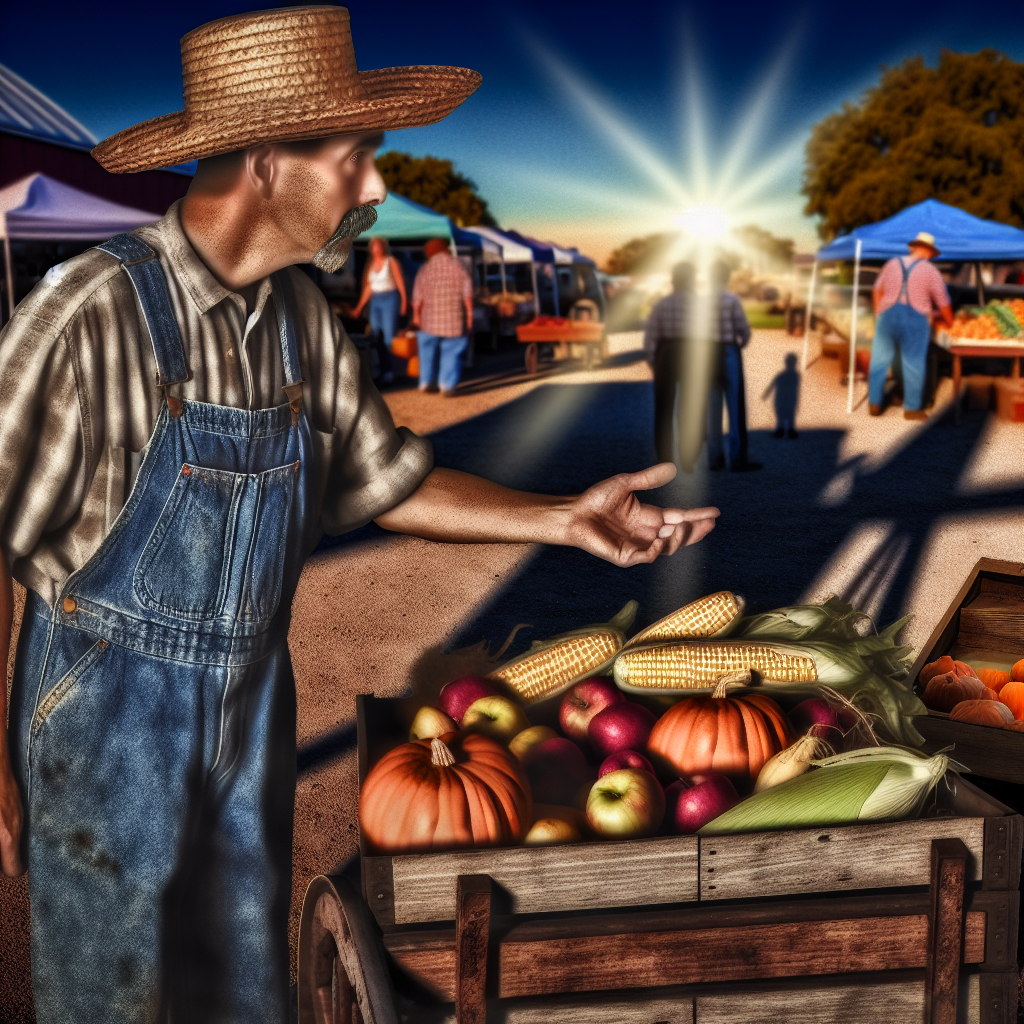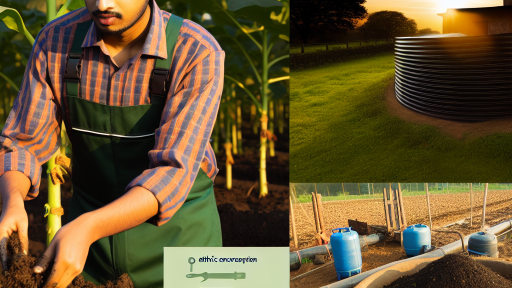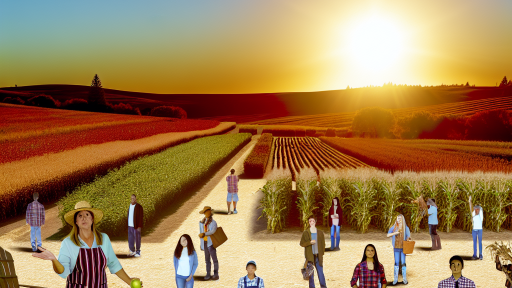Introduction to Direct Sales and Traditional Distribution
Farmers face a crucial decision about how to sell their products.
They can opt for direct sales methods or traditional distribution channels.
Understanding these options helps farmers maximize profitability.
Direct sales involve selling directly to consumers.
This method allows farmers to establish a strong connection with their customers.
Common forms of direct sales include farmers’ markets and online platforms.
Conversely, traditional distribution channels typically involve intermediaries.
These include wholesalers and retailers who handle products before reaching consumers.
Using traditional methods can lead to lower prices for farmers.
However, these prices often come with a cost in terms of control and margins.
For many farmers, choosing between these methods isn’t straightforward.
Each approach presents unique advantages and challenges.
A key consideration involves how much control a farmer desires over pricing.
Direct sales often yield higher profit margins.
On the other hand, traditional distribution provides access to a broader market.
Transform Your Agribusiness
Unlock your farm's potential with expert advice tailored to your needs. Get actionable steps that drive real results.
Get StartedFarmers should carefully assess their market, resources, and goals.
This evaluation will guide them toward the best sales strategy.
Additionally, understanding consumer preferences plays a vital role.
Today’s consumers often seek fresh, locally sourced products.
This trend favors direct sales for many farmers.
Ultimately, the right decision lies in aligning sales methods with the farmer’s vision.
Exploring both direct sales and traditional distribution can yield valuable insights.
Advantages of Direct Sales for Farmers
Higher Profit Margins
Direct sales allow farmers to keep more profits.
They eliminate middlemen from the sales process.
This approach often results in better pricing for both farmers and consumers.
Farmers can set competitive prices while increasing their earnings.
Better Customer Relationships
Direct sales foster strong relationships with customers.
Farmers can communicate directly with their buyers.
This interaction builds trust and loyalty over time.
Farmers gain direct feedback on their products for improvement.
Increased Market Control
Direct sales provide farmers with greater control over their marketing.
Farmers can tailor their messages to attract their target audience.
They can decide when and where to sell their products.
This flexibility can lead to more effective sales strategies.
Enhanced Brand Development
Farmers can develop their own brand through direct sales.
A strong brand creates recognition and customer loyalty.
This approach allows farmers to differentiate their products in the market.
Brand development can result in long-term business sustainability.
Access to Diverse Markets
Direct sales open up diverse market opportunities for farmers.
Showcase Your Farming Business
Publish your professional farming services profile on our blog for a one-time fee of $200 and reach a dedicated audience of farmers and agribusiness owners.
Publish Your ProfileFarmers can explore farmers’ markets, online sales, and local restaurants.
This access can boost their customer base significantly.
Diverse markets often lead to increased sales volume.
Adaptation to Consumer Trends
Direct sales allow farmers to adapt quickly to consumer preferences.
They can introduce new products based on current trends.
This responsiveness can enhance their competitive edge.
Farmers can react promptly to changing market demands.
Challenges of Direct Sales in Agricultural Markets
Market Penetration
Many farmers struggle to enter saturated markets.
Consumer preferences often favor established brands.
This makes it difficult for new entrants to gain traction.
Additionally, brand recognition can greatly influence buyer choices.
Farmers must invest time and resources to build their brand.
Distribution Logistics
Managing logistics presents a significant challenge for direct sales.
Farmers must handle sourcing, storage, and transportation effectively.
This can strain resources and add complexity to operations.
Furthermore, ensuring product freshness is crucial in food sales.
Delays in delivery can lead to loss of product quality.
Consumer Education
Educating consumers about the benefits of direct sales is essential.
Many buyers are unaware of the quality differences available.
Farmers need to communicate their value proposition clearly.
Additionally, creating awareness requires continuous marketing efforts.
Social media can be a valuable tool for this purpose.
Regulatory Compliance
Navigating regulatory requirements can be daunting.
Farmers must comply with food safety and labeling laws.
This often requires additional paperwork and inspections.
Failure to comply can lead to fines or product recalls.
It is essential to stay informed about local regulations.
Cost Considerations
Direct sales can entail higher costs than traditional distribution.
Farmers often bear the financial burden of marketing and logistics.
This poses a risk, especially for small-scale producers.
As a result, balancing costs while maintaining product quality is critical.
Farmers must evaluate their pricing strategies carefully.
Learn More: Challenges in Direct-to-Consumer Farming Sales
Benefits of Traditional Distribution Channels
Established Market Access
Traditional distribution channels provide farmers with established market access.
This access helps farmers reach customers they may not reach individually.
Retailers and wholesalers often have loyal customer bases.
Therefore, partnering with these entities can boost sales significantly.
Reduced Marketing Burden
Using traditional distribution channels lessens the marketing burden on farmers.
Farmers can focus on producing quality products instead of marketing.
Retailers manage advertising and promotions for the products they sell.
Showcase Your Farming Business
Publish your professional farming services profile on our blog for a one-time fee of $200 and reach a dedicated audience of farmers and agribusiness owners.
Publish Your ProfileConsequently, farmers benefit from increased exposure without extra effort.
Economies of Scale
Traditional distribution often leverages economies of scale.
As distribution companies handle larger volumes, costs decrease.
This reduction in cost can lead to higher profit margins for farmers.
Additionally, it allows farmers to invest in other areas of their business.
Expertise in Distribution
Distributors bring specialized expertise to the sales process.
Their knowledge of logistics ensures efficient product delivery.
Farmers can rely on these experts to navigate complex supply chains.
This collaboration can lead to improved inventory management and product placement.
Risk Mitigation
Involving traditional distributors offers risk mitigation for farmers.
Distributors often absorb some financial risks associated with selling products.
This arrangement can shield farmers from market fluctuations.
Consequently, farmers can focus more on production rather than sales volatility.
Relationship Building
Traditional distribution channels foster strong relationships over time.
These relationships can lead to better pricing and negotiation power.
Furthermore, long-standing partnerships can yield strategic advantages.
Farmers benefit from the trust and knowledge built through these relationships.
Discover More: Impact of CSA on Local Farming Communities
Drawbacks of Traditional Distribution for Farmers
Complex Supply Chains
Traditional distribution often involves complex supply chains.
These chains can be confusing and difficult to navigate.
Consequently, farmers may struggle to get their products to market.
This complexity can lead to delays and increased costs.
Reduced Profit Margins
Farmers face reduced profit margins with traditional distribution.
Middlemen often take a significant cut of the profits.
This leaves farmers with less money for their hard work.
As a result, many farmers struggle financially.
Lack of Control Over Pricing
Traditional distribution models often mean farmers lack pricing control.
Middlemen dictate prices, forcing farmers to accept less.
This can lead to dissatisfaction and uncertainty in income.
Moreover, price fluctuations can further hurt farmers financially.
Dependency on Retailers
Farmers become overly dependent on retailers in traditional distribution.
When retailers set high purchasing requirements, farmers may suffer.
This dependency limits farmers’ flexibility and negotiation power.
Consequently, many farmers feel trapped in their distribution agreements.
Limited Market Access
Many farmers experience limited market access through traditional channels.
This lack of access prevents farmers from reaching consumers directly.
As a result, they miss out on valuable sales opportunities.
Moreover, consumers are often unaware of where their food comes from.
Inconsistent Quality Control
Traditional distribution can lead to inconsistent quality control.
Farmers often lose touch with their products once they leave the farm.
Showcase Your Farming Business
Publish your professional farming services profile on our blog for a one-time fee of $200 and reach a dedicated audience of farmers and agribusiness owners.
Publish Your ProfileThis can result in quality degradation during transportation.
Consequently, consumers receive a different product than expected.
Environmental Impact
Traditional distribution contributes to increased environmental impact.
Long transportation routes result in higher carbon emissions.
This not only affects the planet but also increases costs for farmers.
Moreover, excessive packaging waste can add to environmental concerns.
Uncover the Details: Seasonal Eating Practices for Farm-to-Table Farmers

Case Studies: Successful Direct Sales Models
Farmers’ Markets: A Community Hub
Local farmers markets provide a vibrant space for producers and consumers to connect.
For example, the Greenfield Farmers Market thrives every Saturday.
This market features over thirty local vendors selling fresh produce.
Community members enjoy the opportunity to meet their farmers directly.
Such interactions build trust and foster long-lasting relationships.
Subscription-Based Delivery Services
Subscription models allow farmers to deliver fresh goods directly to consumers.
One successful example is Bloom Box Organics.
This small farm offers weekly delivery of seasonal produce to local households.
Customers appreciate the convenience and freshness of their weekly boxes.
This service encourages a steady revenue stream for farmers.
Direct-to-Consumer Online Sales
Many farmers are now leveraging e-commerce to sell their products.
A great case is Maple Grove Farm.
They launched an intuitive website showcasing their organic products.
Through this platform, they reach a broader audience beyond local sales.
Online orders increase their overall sales and brand exposure.
Community Supported Agriculture (CSA)
CSAs involve consumers investing in a farm’s season before harvest.
For instance, Riverside Farms successfully runs a CSA program.
Members pay upfront for a share of the season’s produce.
This model ensures farmers receive income early in the growing season.
Moreover, it strengthens the bond between farmers and their community.
Collaborative Selling Models
Farmers in some regions collaborate to enhance their market reach.
One such initiative is the Local Harvest Collective.
Several farms pool resources to create a shared online store.
This partnership allows them to offer diverse product selections.
They benefit from reduced costs and increased customer appeal.
Learn More: Essential Small-Scale Farming Techniques for Beginners
Impact of Technology on Distribution Strategies
The Rise of E-commerce
Technology has revolutionized the way farmers sell their products.
E-commerce platforms allow direct interaction with consumers.
Farmers can now showcase their goods online, reaching broader markets.
This shift reduces reliance on traditional wholesalers and retailers.
Moreover, it helps farmers build their brand presence directly.
Supply Chain Transparency
Advanced technologies enhance supply chain transparency.
Farmers can track their products from farm to table.
Showcase Your Farming Business
Publish your professional farming services profile on our blog for a one-time fee of $200 and reach a dedicated audience of farmers and agribusiness owners.
Publish Your ProfileConsumers appreciate knowing the source of their food.
This transparency can increase customer trust and loyalty.
As a result, customers are willing to pay a premium for fresh produce.
Utilization of Data Analytics
Data analytics allows farmers to make informed decisions.
They can analyze market trends and consumer preferences efficiently.
This information helps strategically plan production and distribution.
Additionally, it minimizes waste by aligning supply with demand.
Such insights foster adaptability in a rapidly changing market.
Mobile Technology and On-the-Go Sales
Mobile technology provides farmers with flexibility and convenience.
Farmers can now sell products at local farmers’ markets remotely.
Mobile apps facilitate easy communication between farmers and consumers.
This accessibility enhances customer engagement and sales opportunities.
As a consequence, farmers can capitalize on impulse purchasing behaviors.
Social Media as a Marketing Tool
Social media platforms are powerful marketing tools for farmers.
They enable targeted advertising to specific demographics.
Farmers can share the story behind their products, creating connections.
Building a community around their brand becomes feasible.
Ultimately, this strategy increases brand visibility and sales.
Future Trends in Farming Distribution Methods
Shifts Towards Direct Sales
Farmers increasingly adopt direct sales strategies.
This method enhances profit margins and fosters customer relationships.
Farmers are leveraging online platforms to reach consumers.
Moreover, direct sales allow for fresher products and immediate feedback.
Emergence of Technology and Automation
Advancements in technology are transforming distribution methods.
Smart logistics systems optimize delivery times and reduce waste.
Farmers utilize drones for efficient crop monitoring and inventory management.
Consequently, these innovations streamline operations significantly.
Focus on Sustainable Practices
Sustainability remains a priority for modern farmers.
Eco-friendly distribution methods reduce carbon footprints.
Farmers are seeking local buyers to minimize transportation impacts.
Additionally, sustainable practices resonate with today’s environmentally conscious consumers.
Collaboration with Local Businesses
Partnerships with local businesses enhance distribution opportunities.
Farmers collaborate with restaurants and grocery stores for direct supply.
Such links bolster community support and stimulate local economies.
Furthermore, they offer consumers farm-fresh options nearby.
Utilization of Social Media
Social media platforms play a vital role in marketing products.
They allow farmers to directly engage with their audience.
Farmers share their stories, creating a loyal customer base.
This engagement builds trust and enhances brand visibility.
Growth of Subscription Services
Subscription services are gaining popularity among consumers.
These services provide consistent access to fresh produce.
Showcase Your Farming Business
Publish your professional farming services profile on our blog for a one-time fee of $200 and reach a dedicated audience of farmers and agribusiness owners.
Publish Your ProfileFarmers benefit from predictable revenue streams and enhanced customer loyalty.
Many consumers appreciate the convenience of doorstep delivery.
Innovation in Packaging Solutions
Innovative packaging solutions are evolving rapidly.
Eco-friendly options reduce waste and appeal to consumers.
Smart packaging keeps products fresh longer, enhancing quality.
These improvements align with growing sustainability trends in farming.
Additional Resources
The Role of Local and Regional Food Systems in U.S. Farm Policy
Farm to Table: Building Local and Regional Food Systems – SARE




